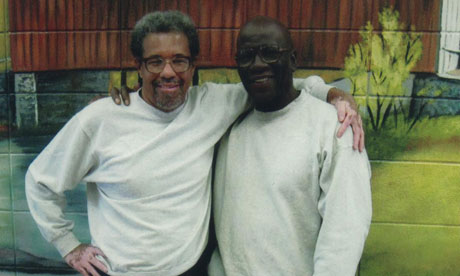Forty years in solitary: two men mark sombre anniversary in Louisiana prison

On Tuesday, Wallace and his friend Albert Woodfox will mark one of the more unusual, and shameful, anniversaries in American penal history. Forty years ago to the day, they were put into solitary confinement in Louisiana's notorious Angola jail. They have been there ever since.
They have spent 23 hours of every one of the past 14,610 days locked in their single-occupancy 9ft-by-6ft cells. Each cell, Amnesty International records, has a toilet, a mattress, sheets, a blanket, pillow and a small bench attached to the wall. Their contact with the world outside the windowless room is limited to the occasional visit and telephone call, "exercise" three times a week in a caged concrete yard, and letters that are opened and read by prison guards.
A new documentary film takes us into that cell, providing rare insight into the personal psychological impact of such prolonged isolation. Herman's House tracks the experiences and thoughts of Wallace as he reflects on four decades banged away in a box.
The film is based on recorded telephone conversations between Wallace and the documentary's director Angad Bhalla. Wallace, a New Orleans native now aged 70, speaks with powerful understatement about his time in solitary.

In recordings that are not included in the film but have been made available to the Guardian, Wallace gives more detail about his cell: "Every time I stand up from the bed I could hit my hips on the table, it's that close. As far as moving about – there is no movement. I suffer from arthritis that has come about because of being in the cell."
Wallace was first imprisoned in 1967 after he commited a bank robbery. The late sixties were a heady time inside Angola, reputed to be the worst jail in America, whose 5,000 inmates were still racially segregated and where violence and sexual slavery were rampant.
Wallace, Woodfox and a third black man, Robert King, came together to form a chapter of the Black Panther movement inside the prison, hoping to organise African American inmates against the brutal treatment they endured. Then on April 17, 1972, a prison guard called Brent Miller was murdered during an arrest on one of the wings.
The Angola 3 were immediately accused of the murder, and placed that same day in solitary. They have insisted ever since on their innocence, pointing to the lack of any physical evidence linking them to Miller's death and suggestions that the main eyewitness against them was bribed by prison officials.
They say that the murder charge was trumped up to punish them for their political activities.
Since 1972, Wallace and Woodfox have been brought before more than 150 prison boards where their unprecedented duration in solitary confinement has been reviewed only for them to be sent straight back to their cells. The only explanation given: "Nature of the original reason for lockdown".
"This is a case of innocence and the abuse of human rights," Robert King said on the eve of the anniversary. King's conviction was overturned and he was released in 2001, and he said he fears for his former fellow inmates now bearing in mind that they have spent more than a decade longer in solitary than he did.
"I was in a six-by-nine cell for 29 years and I know what it did to me – it shunk the brain, it shrunk the individual. You become acclimatised to small distances."
Amnesty hopes to build pressure on the governor of Louisiana, Bobby Jindal, to release the two remaining men from solitary by delivering a petition bearing more than 65,000 signatures to the Louisiana State Capitol in Baton Rouge on Tuesday. The human rights organisation decries their prolonged solitary incarceration as a form of cruel and inhumane treatment that is banned under both the US constitution and international law.
In his recorded conversations with Bhalla, Wallace gives a glimpse into his mental state after so long alone. He says his memory is deteriorating. "A lot of times I lose it. I have trouble coming up with the simplest of things, the A,B,C..."
Many days he doesn't bother to come out of his cell at all, he tells Balla. "I have to spend a lot of time reading and writing. It helps me to maintain what little sanity I have left, to maintain humanity and dignity and to fight back to what people are trying to do to Albert and I from a mental perspective."
The film follows the relationship between Wallace and a young artist called Jackie Sumell who was so outraged by his story that she decided to help him imaginatively escape from solitary confinement by having him design his perfect house. She asked him to describe to her the ideal house of his dreams.
"What kind of house do a man in solitary dream about?" he says in the film. "I don't dream about no house. Being out there in the streets, even if I was homeless, I'd be satisfied."
But he does go on to design for Sumell his perfect house, sending her drawings and descriptions in words from which she builds a recreation of Herman's house as an art installation.
"In the front of the house," he writes, "I have gardens full of gardenias, carnations and tulips. This is of the utmost importance. I would like my guests to be able to smile and watch the flowers all day long."
Beside the gardens is a swimming pool with a large black panther drawn in tiles on the bottom. Entering the house, there is a wall lined with portraits of rebel slave leaders and abolitionists – Gabriel Prosser, Denmark Vesey, Nat Turner, John Brown and Harriet Tubman.
In the master bedroom upstairs there is a king-sized bed, African art on the walls, and a mirror ceiling (remember, Wallace has been jailed since 1967). Next to the bedroom is an ensuite bathroom which contains the most telling imaginary detail of all: a bath tub in which the free Herman Wallace will be able to wallow.
It measures 9ft by 6ft, the size of his cell for the past 40 years.
Herman's House, directed by Angad Bhalla and produced by Lisa Valencia-Svensson, will be shown at the Hot Docs International Documentary Festival on April 27.



No comments:
Post a Comment